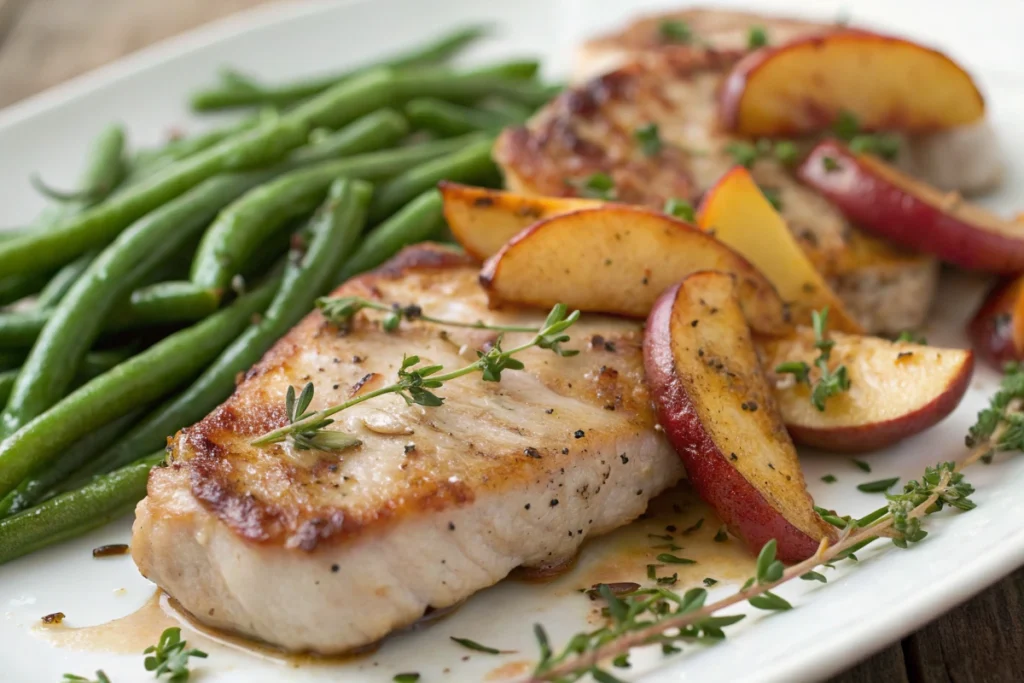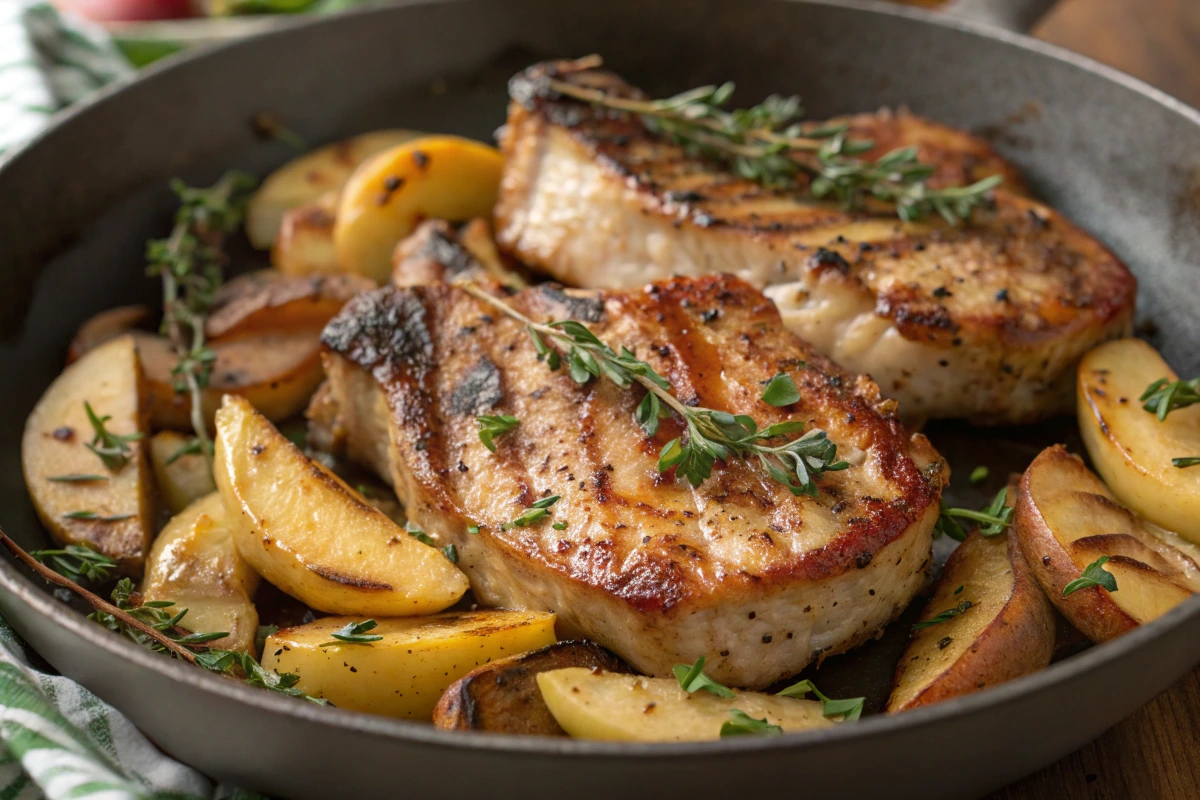When it comes to blending savory and sweet, few dishes rival the delectable combination of pork chops with roasted apples and Herbes de Provence. This classic French-inspired recipe offers a medley of flavors—succulent pork, caramelized apples, and the fragrant herb blend of Provence, creating a meal that’s as comforting as it is impressive. In this article, we’ll explore everything from the origins of Herbes de Provence to expert tips for preparing pork chops and apples perfectly. Whether you’re a seasoned chef or a kitchen newbie, this guide will help you create a dish worthy of a five-star table.
Let’s dive into the delicious world of French cuisine, starting with an overview of this dish’s appeal and flavor profile.
Table of contents
- Introduction to Pork Chops with Roasted Apples and Herbes de Provence
- Understanding Herbes de Provence
- Selecting the Perfect Pork Chops
- Choosing the Right Apples for Roasting
- Preparing Ingredients for Pork Chops and Roasted Apples
- Cooking Techniques for Pork Chop with Roasted Apples Recipe Herbes de Provence
- Serving Pork Chops with Roasted Apples
- Storage and Reheating Tips
- Important Nutrients Table for Pork Chops with Roasted Apples and Herbes de Provence
- Frequently Asked Questions
- What is the secret to moist pork chops?
- Why do apples go with pork chops?
- What to serve with pork chops and apples ?
- How do you cook pork chops with roasted apples and herbes de provence?
- What is the origin of Herbes de Provence?
- Can I substitute dried herbs for fresh ones in this recipe?
- How can I ensure my pork chops remain juicy?
- Conclusion
Introduction to Pork Chops with Roasted Apples and Herbes de Provence
The Allure of French Cuisine
French cooking has long been synonymous with elegance and balance. From delicate pastries to hearty entrées, every dish is crafted to delight the senses. Among these treasures, pork chops with roasted apples and Herbes de Provence stand out as a shining example of how simple ingredients can yield extraordinary flavors. The blend of savory, sweet, and herbal notes embodies the French philosophy of culinary harmony, making this recipe a must-try for food lovers everywhere.
Overview of the Dish
At its heart, this recipe is all about combining the natural sweetness of roasted apples with the savory goodness of perfectly cooked pork chops. Adding Herbes de Provence, a fragrant mix of dried Mediterranean herbs like thyme, rosemary, and lavender, elevates the dish to gourmet status. The result? A mouthwatering entrée that’s as suitable for a weeknight dinner as it is for a special occasion. Pair it with rustic sides like mashed potatoes or green beans, and you’ve got a meal that’s sure to please any crowd.
This dish is more than just a recipe; it’s an experience—a journey into the heart of French cooking, where simplicity meets sophistication. So, roll up your sleeves and get ready to create something truly unforgettable. In the next section, we’ll dive into the history and unique qualities of Herbes de Provence.

Understanding Herbes de Provence
Origins and Composition
Herbes de Provence is a fragrant herb blend rooted in the culinary traditions of southern France. Named after the Provence region, this mixture embodies the essence of Mediterranean cooking. Traditionally, it combines thyme, rosemary, oregano, and savory, but variations may include lavender, marjoram, or fennel. This unique mix delivers a delicate yet earthy aroma that pairs beautifully with meats, vegetables, and even breads.
What makes Herbes de Provence stand out is its versatility. The herbs are dried, which intensifies their flavor, making them ideal for roasting and slow cooking. When used in this pork chop with roasted apples recipe herbes de provence, the blend brings depth and balance to the dish, enhancing both the sweetness of the apples and the savory notes of the pork.
Culinary Applications
Herbes de Provence isn’t limited to pork dishes—it’s a staple in many kitchens for a reason. From roasted chicken and grilled fish to ratatouille and baked potatoes, this herb mix can elevate almost any dish. In this recipe, it plays a starring role by seasoning the pork and infusing the apples with a subtle, aromatic complexity.
To maximize the flavor, you can rub Herbes de Provence directly onto the pork chops before cooking. Alternatively, you can sprinkle it over the apples as they roast to add an herbal dimension to their caramelized sweetness. It’s this adaptability that makes the blend a favorite among chefs and home cooks alike.
Selecting the Perfect Pork Chops
Types of Pork Chops
Choosing the right cut of pork is essential for creating the perfect pork chop with roasted apples recipe herbes de provence. Pork chops come in several varieties, including bone-in, boneless, loin chops, and rib chops. Bone-in chops, for instance, tend to retain more moisture and flavor during cooking, making them ideal for recipes where tenderness is key.
Boneless chops, on the other hand, are leaner and cook faster, which can be an advantage if you’re pressed for time. Rib chops, with their slightly higher fat content, are incredibly flavorful and create a rich, satisfying bite. For this recipe, bone-in rib chops are particularly well-suited as they complement the sweetness of roasted apples and the aromatic Herbes de Provence.
Quality Indicators
When shopping for pork, keep an eye out for high-quality cuts. Look for meat that is light pink with a small amount of marbling—this ensures tenderness and flavor. Avoid chops with excessive fat or a dull color, as these can indicate lower quality or older cuts.
If possible, opt for pork from a trusted butcher or local farm. Not only does this support sustainable farming practices, but it also ensures you’re getting fresh, flavorful meat. By choosing the right pork chops, you’ll set the stage for a dish that’s juicy, tender, and full of flavor.
In the next section, we’ll explore how to pick the perfect apples to pair with your pork chops. Stay tuned!
Choosing the Right Apples for Roasting
Flavor Profiles
Selecting the appropriate apple variety is crucial for achieving the perfect balance in your pork chop with roasted apples recipe herbes de provence. Apples range from sweet to tart, and their flavors can significantly influence the dish’s overall taste. Sweet apples, such as Fuji or Gala, offer a honeyed flavor that complements the savory pork. In contrast, tart apples like Granny Smith provide a sharpness that cuts through the richness of the meat, adding a refreshing contrast.
When choosing apples, consider the desired flavor balance. Combining both sweet and tart varieties can create a more complex and satisfying taste experience. This blend enhances the dish’s depth, making each bite a delightful journey of flavors.
Best Apple Varieties for Roasting
Not all apples are suitable for roasting; some become mushy, while others hold their shape well. For this recipe, it’s essential to select apples that maintain their structure and develop a rich, caramelized flavor when roasted. Here are some top choices:
- Honeycrisp: Known for its crisp texture and balanced sweetness, Honeycrisp apples roast beautifully, retaining their shape and adding a pleasant crunch.
- Granny Smith: These tart apples offer a firm texture that holds up well under heat, providing a tangy counterpoint to the savory pork and herbs.
- Braeburn: With a balance of sweet and tart flavors, Braeburn apples become tender yet firm when roasted, making them an excellent choice for this dish.
By selecting the right apple varieties, you’ll enhance the harmony of flavors in your pork chop with roasted apples recipe herbes de provence, creating a memorable meal that delights the palate.
For more delicious recipes, check out our collection of savory dishes.
Preparing Ingredients for Pork Chops and Roasted Apples
Marinating Pork Chops with Herbes de Provence
Proper preparation of the pork chops is essential to infuse them with the aromatic flavors of Herbes de Provence. Begin by patting the chops dry with a paper towel to remove excess moisture, which helps the marinade adhere better. In a bowl, combine:
- 2 tablespoons of olive oil
- 1 tablespoon of Herbes de Provence
- 2 minced garlic cloves
- Salt and freshly ground black pepper to taste
Mix these ingredients to form a marinade. Rub this mixture generously over each pork chop, ensuring all sides are well coated. Place the chops in a shallow dish, cover, and refrigerate for at least 30 minutes. Marinating allows the herbs and spices to penetrate the meat, enhancing its flavor and tenderness.
Prepping Apples for Roasting with Savory Dishes
While the pork chops marinate, prepare the apples. Start by washing them thoroughly under running water. Peel the apples if desired, though leaving the skin on can add texture and nutrients. Core the apples to remove seeds and slice them into uniform wedges, approximately 1/2 inch thick. Uniform slices ensure even roasting, allowing each piece to caramelize properly.
To prevent browning, toss the apple slices in a bowl with a tablespoon of lemon juice. This step maintains their fresh appearance and adds a subtle brightness to the flavor profile. Once prepped, set the apples aside until ready to roast alongside the pork chops.
By meticulously preparing the ingredients, you set the foundation for a harmonious and flavorful pork chop with roasted apples recipe herbes de provence that showcases the best of French-inspired
Cooking Techniques for Pork Chop with Roasted Apples Recipe Herbes de Provence
Searing Pork Chops to Lock in Juices
To achieve the perfect pork chop with roasted apples recipe herbes de provence, it’s essential to start with a good sear. Heat a large skillet over medium-high heat and add a tablespoon of olive oil. Once the oil is shimmering, carefully place the marinated pork chops into the pan. Let them cook undisturbed for about 3-4 minutes on each side, or until they develop a golden-brown crust. This initial sear locks in the juices and enhances the flavor with a beautifully caramelized exterior.

Avoid overcrowding the pan, as it can lower the temperature and result in uneven cooking. If necessary, sear the chops in batches. After searing, transfer the pork chops to a plate and cover them loosely with foil to retain their warmth.
Roasting Apples to Pair Perfectly with Pork
While the pork chops rest, preheat your oven to 375°F (190°C). Arrange the prepared apple slices on a baking sheet lined with parchment paper. Drizzle the apples with olive oil and sprinkle them with a pinch of salt and Herbes de Provence. Toss gently to coat each piece evenly.
Roast the apples for 15-20 minutes, stirring halfway through to ensure even caramelization. The apples should become tender and slightly golden, with a rich, sweet aroma. Their natural sugars will caramelize beautifully, complementing the savory pork.
Bringing It All Together: The Final Cooking Steps
After the apples have roasted, return the seared pork chops to the skillet. Place the roasted apples around the chops, ensuring the flavors meld as they finish cooking together. Pop the skillet into the oven for an additional 5-7 minutes, or until the pork reaches an internal temperature of 145°F (63°C). Remove from the oven and let the dish rest for a few minutes before serving to allow the juices to redistribute.
Serving Pork Chops with Roasted Apples
Side Dishes for Pork Chops with Apples and Herbes de Provence
Pairing this pork chop with roasted apples recipe herbes de provence with the right sides can elevate your dining experience. For a hearty and comforting meal, serve the dish with creamy mashed potatoes or roasted sweet potatoes. The buttery texture and mild sweetness of these sides beautifully complement the flavors of the pork and apples.
For a lighter option, consider sautéed green beans or steamed asparagus. The fresh, crisp texture of these vegetables provides a refreshing contrast to the rich, savory pork and sweet, caramelized apples. A warm baguette on the side is also a delightful addition for soaking up the flavorful juices.
Wine Pairings to Elevate This Pork and Apple Recipe
Choosing the right wine can make this dish even more memorable. A medium-bodied white wine, such as Chardonnay, pairs beautifully with the subtle herbaceous notes of Herbes de Provence and the sweetness of roasted apples. If you prefer red wine, opt for a light Pinot Noir or a fruity Beaujolais. These reds offer enough acidity to balance the dish without overpowering the flavors.
By selecting complementary sides and a well-matched wine, you’ll create a complete and satisfying meal that highlights the sophisticated flavors of this recipe. Whether it’s a special occasion or a cozy weeknight dinner, this pairing will leave your guests impressed.
Storage and Reheating Tips
Proper storage and reheating of your pork chops with roasted apples and Herbes de Provence ensure the dish stays fresh and flavorful. Store it correctly, and you can enjoy it for days. Keep it in the refrigerator for up to 3-4 days or freeze it for as long as 2 months.
To reheat, use an oven or microwave. For the oven, preheat it to 350°F and heat the dish for 10-15 minutes, ensuring it reaches an internal temperature of 145°F. If you’re using the microwave, heat it in 30-second intervals until the dish reaches the same temperature. These steps are key for safe and delicious reheating of pork chops with roasted apples and Herbes de Provence.
Additional Storage and Reheating Tips:
- Store the dish in an airtight container to lock in flavors and prevent moisture loss.
- Label the container with the date and contents for easy reference.
- Always reheat evenly to ensure food safety and prevent cold spots.
These tips will help you savor your pork chops with roasted apples and Herbes de Provence longer. For roasting apples, choose varieties that suit your taste—Granny Smith, Honeycrisp, and Fuji are excellent options.
Finally, always check that the internal temperature of the dish is 145°F before serving. Enjoy your flavorful pork chops with confidence!
| Storage Method | Storage Time | Reheating Method |
|---|---|---|
| Refrigerator | 3-4 days | Oven or Microwave |
| Freezer | 2 months | Oven or Microwave |
Important Nutrients Table for Pork Chops with Roasted Apples and Herbes de Provence
| Nutrient | Amount per Serving |
|---|---|
| Calories | 450 kcal |
| Protein | 36 g |
| Total Fat | 20 g |
Nutritional Overview:
This dish provides a well-balanced combination of nutrients, making it both hearty and satisfying. The calories (450 kcal per serving) reflect the energy-rich nature of the meal, ideal for a fulfilling dinner. Packed with protein (36 g per serving), it supports muscle maintenance and keeps you feeling full longer. The total fat (20 g) adds richness and flavor, with a moderate amount that complements a balanced diet.
Enjoy this dish as part of a nutritious meal that highlights the perfect harmony of French-inspired flavors and essential nutrients!
Frequently Asked Questions
What is the secret to moist pork chops?
The secret to moist pork chops is choosing thicker, bone-in cuts and brining them to retain moisture. Cook the chops to an internal temperature of 145°F (63°C) and avoid overcooking. Searing the chops before baking or finishing in the oven locks in the juices and adds flavor.
Why do apples go with pork chops?
Apples pair perfectly with pork chops because their natural sweetness complements the savory flavor of the meat. The tartness of certain apple varieties balances the richness of pork, creating a harmonious blend of flavors. When roasted or caramelized, apples add a warm, comforting touch to the dish. This classic combination is rooted in tradition and celebrated for its delicious contrast of sweet and savory.
What to serve with pork chops and apples ?
Serve pork chops and apples with creamy mashed potatoes, roasted vegetables like carrots or Brussels sprouts, or a fresh green salad for balance. For a heartier option, pair with wild rice or buttery dinner rolls. These sides enhance the sweet and savory flavors of the dish perfectly.
How do you cook pork chops with roasted apples and herbes de provence?
To cook pork chops with roasted apples and Herbes de Provence, start by marinating the chops with olive oil, Herbes de Provence, garlic, salt, and pepper. Sear them in a hot skillet until golden brown, then transfer to the oven at 375°F to finish cooking. Roast apple slices separately with olive oil and a sprinkle of Herbes de Provence until caramelized. Combine the apples and pork chops for the final few minutes in the oven. Ensure the pork reaches an internal temperature of 145°F before serving.
What is the origin of Herbes de Provence?
Herbes de Provence is a traditional blend of dried herbs that hails from the Provence region in southeastern France. This aromatic mix reflects the area’s Mediterranean roots, where herbs like thyme, rosemary, and oregano grow abundantly. Historically, these herbs were gathered fresh and used in daily cooking, often to season meats, vegetables, and breads. Over time, the blend became a dried staple, allowing cooks worldwide to bring a touch of Provence to their kitchens. In this pork chop with roasted apples recipe herbes de provence, the herb mix adds depth and a distinct French flair.
Can I substitute dried herbs for fresh ones in this recipe?
Absolutely! While fresh herbs can provide a more vibrant flavor, dried Herbes de Provence is commonly used in this recipe and works just as well. If you choose to substitute fresh herbs, use about three times the amount specified for dried herbs, as fresh ones are less concentrated. For example, replace 1 teaspoon of dried Herbes de Provence with 1 tablespoon of fresh herbs. This adjustment ensures the flavor remains balanced without overpowering the dish.
How can I ensure my pork chops remain juicy?
Keeping pork chops juicy often depends on cooking techniques. To avoid dryness, start by searing the chops over high heat to lock in the juices. Then, finish cooking in the oven at a moderate temperature to maintain tenderness. Using a meat thermometer is key—remove the pork from the oven once it reaches an internal temperature of 145°F (63°C). Let the chops rest for 3-5 minutes before serving, allowing the juices to redistribute. Following these steps will help you achieve moist and flavorful pork chops every time.
Conclusion
Recap of the Dish’s Appeal
This pork chop with roasted apples recipe herbes de provence is more than just a meal—it’s a culinary experience that brings together the best of French flavors. The savory pork, caramelized apples, and aromatic Herbes de Provence create a dish that’s both hearty and elegant. Whether you’re preparing dinner for your family or hosting a special gathering, this recipe is sure to impress with its harmonious blend of sweet and savory elements.
Invitation to Experiment
While the recipe is perfect as is, it also offers plenty of room for creativity. Feel free to experiment with different apple varieties or even swap the Herbes de Provence for other herb blends to tailor the flavors to your taste. Pair the dish with sides and wines that suit the occasion, and don’t hesitate to make it your own.
Cooking is all about exploring new flavors and enjoying the process. With this recipe, you’ll not only savor a delicious meal but also celebrate the art of bringing ingredients together in harmony. So, gather your tools, preheat your oven, and get ready to create a French-inspired masterpiece!

